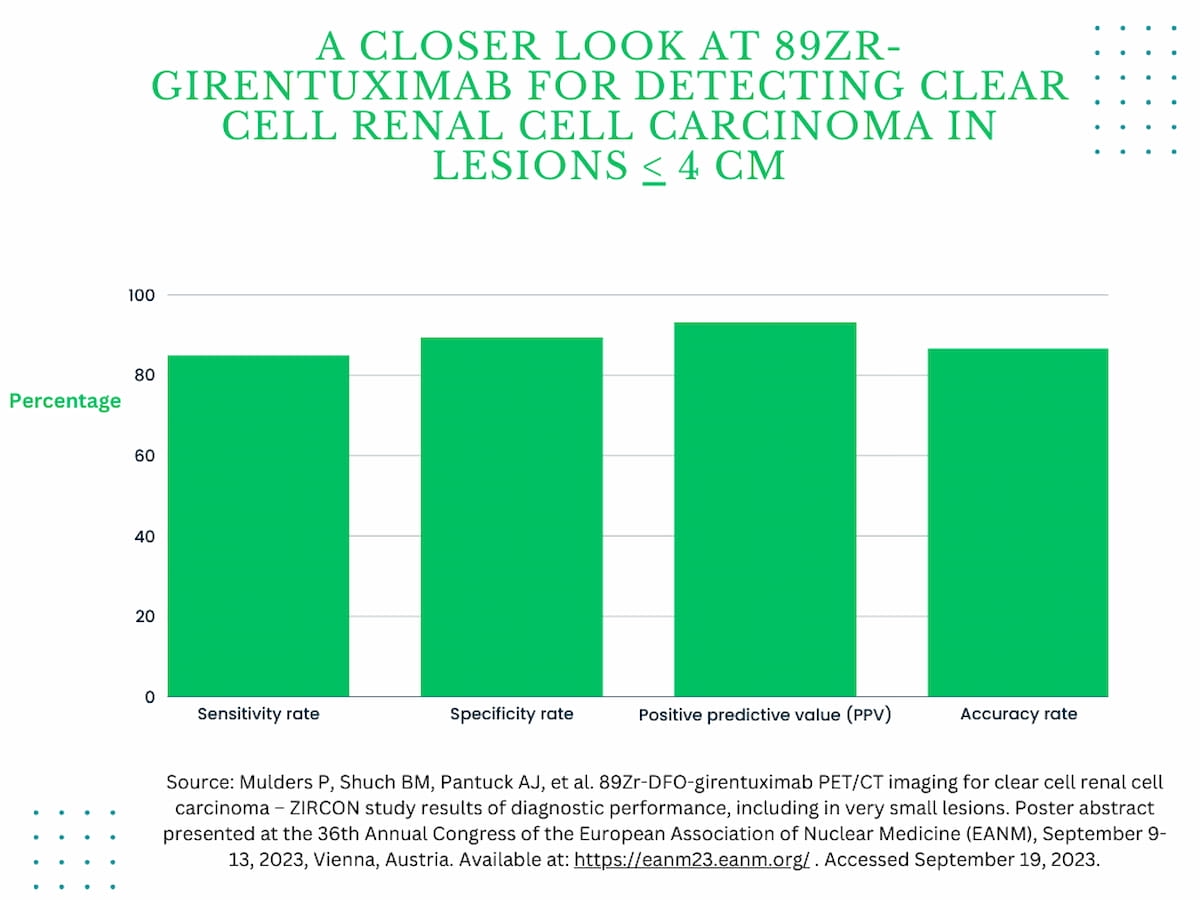Emerging PET/CT Agent May Enhance Diagnosis for Smaller Lesions of Clear Cell Renal Cell Carcinoma
For cT1 renal masses < 4 cm and renal masses < 2 cm, the PET/CT agent 89Zr-DFO-girentuximab had respective sensitivity rates of approximately 85 percent and 96.7 percent for diagnosing clear cell renal cell carcinoma, according to research recently presented at the European Association of Nuclear Medicine (EANM) 2023 Congress.
Given the challenges in detecting malignant clear cell renal cell carcinoma (ccRCC) with conventional anatomic imaging and estimates that between 20 to 30 percent of resected small renal masses are benign, a non-invasive alternative is needed to detect and characterize these lesions.
The positron emission tomography/computed tomography (PET/CT) agent 89Zr-DFO-girentuximab (Telix Pharmaceuticals) may provide a viable imaging alternative for detecting smaller lesions of ccRCC, according to research from the ZIRCON study, which was presented at the recent European Association of Nuclear Medicine (EANM) 2023 Congress in Vienna, Austria.
Researchers found that 89Zr-DFO-girentuximab had an 84.98 percent sensitivity rate and 89.51 specificity rate for the detection of ccRCC in lesions < 4 cm. The IgG1 kappa light chain chimeric monoclonal antibody also demonstrated a 93.19 positive predictive value (PPV) and an 86.67 accuracy rate for these lesions.
Researchers found that 89Zr-DFO-girentuximab had an 84.98 percent sensitivity rate, an 89.51 specificity rate, a 93.19 positive predictive value (PPV) and an 86.67 accuracy rate for the detection of ccRCC in lesions < 4 cm.

For smaller renal masses < 2 cm, 89Zr-DFO-girentuximab had 96.7 percent sensitivity and specificity rates for ccRCC as well as a 96.7 percent accuracy rate, according to study co-author Clement Bailly, M.D., Ph.D., who is affiliated with the Department of Nuclear Medicine at Nantes University Hospital in Nantes, France.
In an interview earlier this year at the Society of Nuclear Medicine and Molecular Imaging (SNMMI) conference, Jeremie Calais, M.D., MSc, emphasized the ability of 89Zr-DFO-girentuximab to detect different lesion sizes with ccRCC.
“(89Zr-DFO-girentuximab) really provides a great tool for patients with indeterminate mass in the kidney. From seven centimeters to four centimeters to two centimeters, you still keep these good characterization properties,” noted Dr. Calais, an associate professor at the Ahmanson Translational Theranostics Division of the Department of Molecular and Medical Pharmacology at the University of California Los Angeles (UCLA).
(Editor’s note: For related content, see “New Research Shows Viability of PET Imaging Agent for Clear Cell Renal Cell Carcinoma” and “Emerging PET/CT Imaging Agent Shows Promise for Diagnosing Clear Cell Renal Cell Carcinoma.”)
The use of 89Zr-DFO-girentuximab in positron emission tomography (PET) imaging (middle image) indicated that clear cell renal cell carcinoma was highly likely for an incidental 1 cm lesion detected on computed tomography (left image). One can also see the ccRCC lesion highlighted on the fused PET/CT axial view (right). (Images courtesy of the European Association of Nuclear Medicine.)

The study researchers added that 89Zr-DFO-girentuximab has a favorable safety profile. In his EANM presentation, Dr. Bailly noted there were few adverse events (AEs) in the ZIRCON trial that may have been related to the imaging agent and he said most of these AEs were mild.
Reference
1. Mulders P, Shuch BM, Pantuck AJ, et al. 89Zr-DFO-girentuximab PET/CT imaging for clear cell renal cell carcinoma – ZIRCON study results of diagnostic performance, including in very small lesions. Poster abstract presented at the 36th Annual Congress of the European Association of Nuclear Medicine (EANM), September 9-13, 2023, Vienna, Austria. Available at: https://eanm23.eanm.org/ . Accessed September 19, 2023.
Newsletter
Stay at the forefront of radiology with the Diagnostic Imaging newsletter, delivering the latest news, clinical insights, and imaging advancements for today’s radiologists.
The Reading Room Podcast: Current Perspectives on the Updated Appropriate Use Criteria for Brain PET
March 18th 2025In a new podcast, Satoshi Minoshima, M.D., Ph.D., and James Williams, Ph.D., share their insights on the recently updated appropriate use criteria for amyloid PET and tau PET in patients with mild cognitive impairment.
New PET Study Links Higher Education Level to Speed of Tau Accumulation with Alzheimer’s Disease
July 8th 2025For patients with amyloid β (Aβ)-positive findings on positron emission tomography, higher educational attainment was associated with accelerated accumulation and spread of tau, according to new research.
SNMMI: Botox May Facilitate Relief from Dry Mouth Side Effect of PSMA-Targeted Radiopharmaceuticals
June 25th 2025For patients being treated with radiopharmaceutical agents for metastatic prostate cancer, the combination of botulinum toxin and an anti-nausea patch led to a 30 percent reduction in PSMA uptake in the salivary glands, according to preliminary research findings presented at the SNMMI conference.
SNMMI: Can 18F-Fluciclovine PET/CT Bolster Detection of PCa Recurrence in the Prostate Bed?
June 24th 2025In an ongoing prospective study of patients with biochemical recurrence of PCa and an initial negative PSMA PET/CT, preliminary findings revealed positive 18F-fluciclovine PET/CT scans in over 54 percent of the cohort, according to a recent poster presentation at the SNMMI conference.